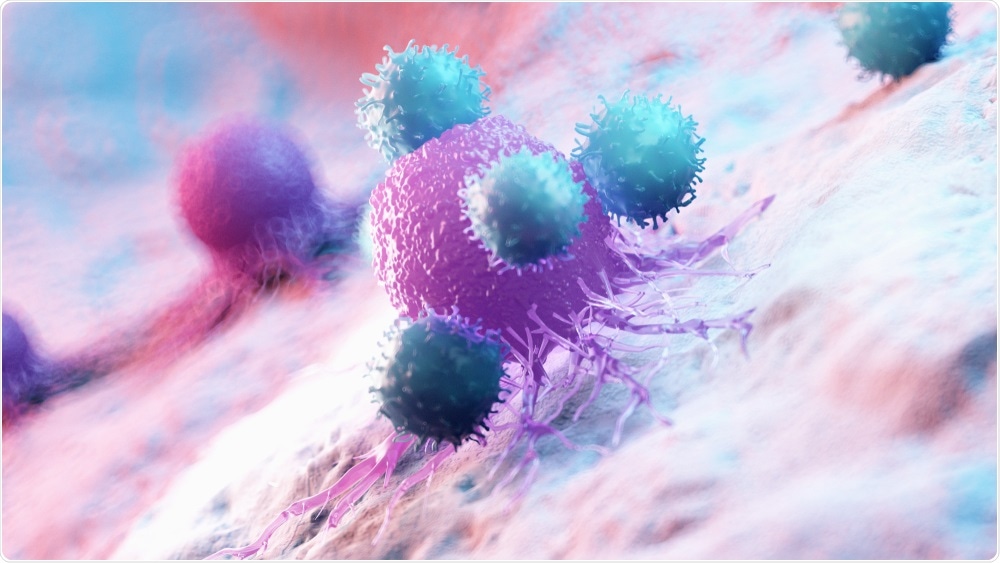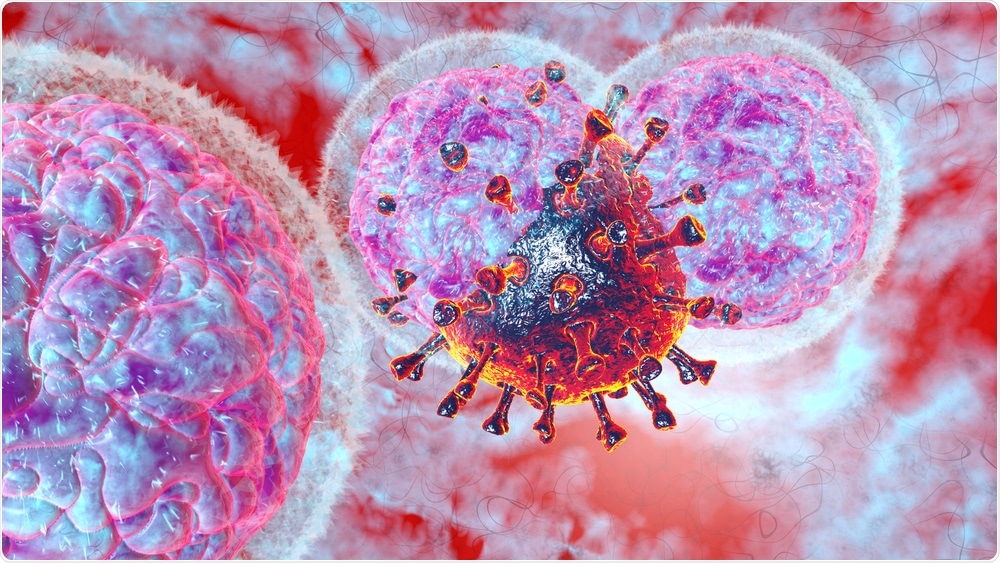Natural killer (NK) cells are a subpopulation of lymphocytes that have various roles within the immune system. To this end, NK cells have unique cell recognition capabilities and have been shown to play a role in controlling viral and intracellular bacterial infections and tumors.
Today, NK cells are used in various therapies, including those to treat cancer and certain viral diseases. Recent studies have found a role of NK cells in fighting coronavirus disease (COVID-19), which is caused by the severe acute respiratory syndrome coronavirus 2 (SARS-CoV-2).
 Study: Natural killer cells in antiviral immunity. Image Credit: Sciepro / Shutterstock.com
Study: Natural killer cells in antiviral immunity. Image Credit: Sciepro / Shutterstock.com
In an effort to further understand the role of NK cells in combatting COVID-19, researchers at the Karolinska University Hospital in Sweden explored NK cells in acute viral infections, citing flavivirus and influenza virus infections as examples. The researchers also studied the activation of NK cells and NK cell function in humans infected with SARS-CoV-2.
Their study, which was published in Nature Reviews Immunology, highlights the role of NK cells in acute viral infections. This data can shed light on how NK cells emerge when a person has COVID-19, which has now infected over 177 million people worldwide.
Natural killer (NK) cells
NK cells are widely known for their cytotoxic function and ability to induce the production of cytokines when stimulated. This population of lymphocytes typically targets infected, transformed, and stressed cells, thereby allowing NK cells to eliminate unwanted cells while also contributing to cellular homeostasis.
NK cells primarily originate from the bone marrow, which is where these cells interact with other cellular components and cytokines to support their development. Recent studies have shown that in addition to the bone marrow, NK cells can also arise from the peripheral blood and secondary lymphoid organs, as well as specific tissues called tissue-resident NK cells. In humans, NK cells are identified as CD3-CD56+ lymphocytes.
During a viral infection, the host cells may become vulnerable to NK cell-mediated recognition through the upregulation of self-encoded molecules triggered by the infection or a cellular stress response. These molecules will then bind to activating NK cell receptors like natural cytotoxicity receptors, C-type lectin-like receptors, and co-activating receptors. Another role of NK cells is to remove virus-infected cells through the CD16-mediated antibody-dependent cellular cytotoxicity (ADCC).
Taken together, NK cell activity is largely modulated by cytokines, including the interleukin-2 (IL-2), IL-12, IL-15, IL-18, and type I interferons. These cytokines, either alone or in combination, can contribute to NK cell survival, proliferation, and cytotoxicity, as well as the ability of NK cells to produce cytokines like interferon-γ (IFN-γ).
NK cell responses to flaviviruses
In their Nature Reviews Immunology study, the investigators reviewed current knowledge about human NK cells in antiviral immunity. During acute infections with flavivirus and influenza virus, which are both RNA viruses, NK cells respond strongly. Viral infections stimulate the activation of circulating NK cells, thus attracting these lymphocytes to the affected tissues. Tissue-resident NK cells can also become activated upon the recognition of these infections, which also plays a role in supporting the immune system’s response.
Flaviviruses such as the dengue virus (DENV), West Nile virus, tick-borne encephalitis virus, Japanese encephalitis virus, Zika virus, and the Yellow fever virus are major emerging hemorrhagic-like syndromes and central nervous system-linked infections. Though there are several vaccines that are currently available to prevent some of these infections, there remains a lack of knowledge regarding which host cells are affected by flaviviruses in humans and whether they are targets of NK cell-mediated responses.
Furthermore, there has also been a lack of studies focusing on NK cells in these specific acute viral infections, aside from the influenza virus. While this may be true, several observational studies have shown that certain types of NK cells; namely, CD56bright and CD56dim NK cells, respond vigorously to infection. In addition to this rise in NK cell activation, these studies have also identified that various cytokines including IL-12, IL-15, IL-18, IFN-γ, and tumor necrosis factor (TNF) also arise during flavivirus infections.
These studies demonstrate the dynamics of the early NK cell response during acute flavivirus infections in humans. However, further studies must still be conducted to elucidate how NK cells influence viral clearance in experimental and human flavivirus infections.
NK cell responses to influenza viruses
Comparatively, the role of NK cells in the host immune response to influenza viruses remains unclear. Influenza viruses cause yearly global epidemics and typically infect about one billion people each year. Although influenza vaccines are readily available each year, they do not provide complete protection against all infections.
In one study, the influenza A virus (IAV) infection in mice was found to trigger the accumulation of NK cells in the lungs. Although the local proliferation of pulmonary NK cells may contribute to this response, most of the NK cells that were found to accumulate in the lungs and airways were tied to NK cell recruitment. More specifically, this NK cell recruitment appeared to be partly dependent on the CXC-chemokine receptor 3 (CXCR3) and CC-chemokine receptor 5 (CCR5).
Many NK cell natural cytotoxicity receptors have also been associated with the activation of NK cells after being infected with the influenza virus. The level at which NK cells contribute to the elimination of the influenza virus, however, is still not fully understood.
The team also noted that the peripheral blood CD56bright and CD56dim NK cells are primed during acute IAV infection.
“Furthermore, in peripheral blood, a small subset of CD16−CD49a+CXCR3+ NK cells has been identified, with CD49a and CXCR3 potentially promoting homing to and tissue retention in the lungs during acute infection.”
A small group of CD16−CD49a+CXCR3+ NK cells has been identified in the peripheral blood, with CD49a and CXCR3 potentially encouraging homing to and tissue retention in the lungs during acute infection. However, at the primary site of infection, it not clear how circulating and tissue-resident NK cells can contribute to antiviral immunity, including that which involves killing bystander cells.
NK cells also respond to chronic viral infections and deficiencies, thus impairing the body’s ability to handle various health conditions such as the herpes virus, human immunodeficiency virus (HIV), and hepatitis infections.
SARS-CoV-2 and NK cells
 Image Credit: Numstocker / Shutterstock.com
Image Credit: Numstocker / Shutterstock.com
Amid the COVID-19 pandemic, scientists focused on NK cells, which were identified as the early responders to acute SARS-Cov-2 infection. The NK cell response to SARS-CoV-2 involves the recruitment of both CD56bright and CD56dim NK cells from the circulation into the lungs, thus leading to a reduction in the number of circulating NK cells.
Lung NK cells are also capable of inducing a gene module for chemotaxis, with patients presenting raised levels of chemokines such as CCL3, CCL3L1, CCL4, CXCL9, CXCL10, and CXCL11. The production of these chemokines suggests that CXCR3 and CCR5 are essential for homing NK cells to the lungs in acute SARS-CoV-2 infection.